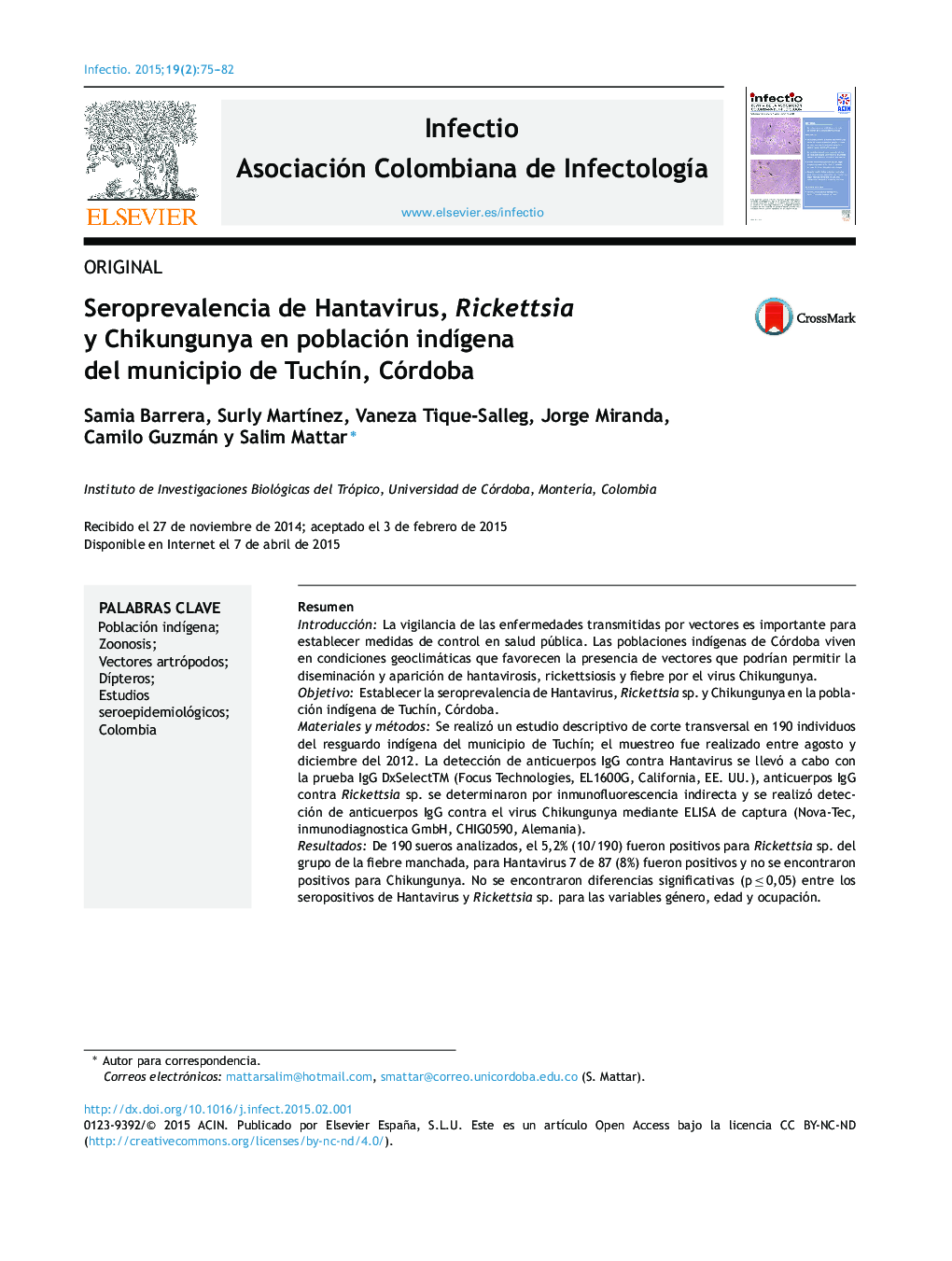| Article ID | Journal | Published Year | Pages | File Type |
|---|---|---|---|---|
| 3403666 | Infectio | 2015 | 8 Pages |
ResumenIntroducciónLa vigilancia de las enfermedades transmitidas por vectores es importante para establecer medidas de control en salud pública. Las poblaciones indígenas de Córdoba viven en condiciones geoclimáticas que favorecen la presencia de vectores que podrían permitir la diseminación y aparición de hantavirosis, rickettsiosis y fiebre por el virus Chikungunya.ObjetivoEstablecer la seroprevalencia de Hantavirus, Rickettsia sp. y Chikungunya en la población indígena de Tuchín, Córdoba.Materiales y métodosSe realizó un estudio descriptivo de corte transversal en 190 individuos del resguardo indígena del municipio de Tuchín; el muestreo fue realizado entre agosto y diciembre del 2012. La detección de anticuerpos IgG contra Hantavirus se llevó a cabo con la prueba IgG DxSelectTM (Focus Technologies, EL1600G, California, EE. UU.), anticuerpos IgG contra Rickettsia sp. se determinaron por inmunofluorescencia indirecta y se realizó detección de anticuerpos IgG contra el virus Chikungunya mediante ELISA de captura (Nova-Tec, inmunodiagnostica GmbH, CHIG0590, Alemania).ResultadosDe 190 sueros analizados, el 5,2% (10/190) fueron positivos para Rickettsia sp. del grupo de la fiebre manchada, para Hantavirus 7 de 87 (8%) fueron positivos y no se encontraron positivos para Chikungunya. No se encontraron diferencias significativas (p ≤ 0,05) entre los seropositivos de Hantavirus y Rickettsia sp. para las variables género, edad y ocupación.ConclusionesLos hallazgos demuestran exposición previa a Rickettsia sp. y a Hantavirus en la población indígena de Tuchín. Los resultados pueden ser útiles para establecer una alerta sobre estas fiebres hemorrágicas. Aunque no se hallaron seropositivos para Chikungunya, este fue el primer trabajo de vigilancia epidemiológica realizado en Colombia sobre este virus.
IntroductionVector-borne disease surveillance is important for establishing control measures in public health. Indigenous populations of Cordoba live in climate conditions that favor the presence of vectors that might allow the spread and emergence of hantavirus cases, rickettsial and Chikungunya fever.ObjectiveTo establish the prevalence of Hantavirus, Rickettsia sp. and Chikungunya in the indigenous population of Tuchín, Cordoba.Materials and methodsA cross-sectional descriptive study on 190 individuals of the indigenous reservation of the municipality of Tuchín was carried out; the serum samples were collected between August and December of 2012. The following serology tests were performed: antibody IgG against Hantavirus IgGDxSelectTM (Focus Technologies, EL1600G, California, USA); indirect immunofluorescence technique for Rickettsia spotted fever group IgG and ELISA IgG antibodies against Chikungunya virus (Nova-Tec, diagnostic GmbH, CHIG0590, Germany).ResultsOut of 190 analyzed sera, 5.2% (10/190) were positive for Rickettsia sp. spotted fever group, Hantavirus 7 of 87 (8.0%) and 0% for Chikungunya. Significant differences among those positive for Hantavirus and Rickettsia sp. for the variables gender, age and occupation were not found.ConclusionsThe findings reveal the prevalence of Rickettsia sp. and Hantavirus in the indigenous population of Tuchín. These results are useful to establishing an alert regarding these hemorrhagic fevers. Although no positive result for Chikungunya virus was found, this is the first epidemiological surveillance study conducted in Colombia on this virus.
